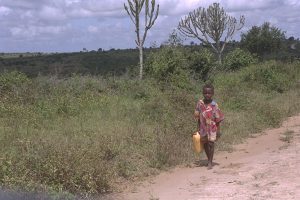2.4 Environmental risks and climate change

Earlier in this module, on page 1.2, the International Rights of the Child were reviewed. Article 24 specifies children’s right to the highest attainable standard of health. The Sustainable Development Goals (SDGs) were adopted by United Nations Member States in 2015 to address global challenges such as poverty, inequality, and climate change. (The 17 interconnected goals are introduced and further explored In the Developmental Health module.) A number of the SDGs highlight the importance of addressing environmental risks and climate change. For example, Goal #3 relates to overall good health and well-being, Goal #6 to clean water and sanitation, and Goal #13 to climate action. The Nurturing Care Framework, discussed in a number of modules, identifies “good health”, and “safety and security” as two of five interconnected components. Environmental risks such as air pollution and lack of access to clean water compromise the health, safety, and security of children and families. Clearly, the role of environment and climate have been recognized as key factors in influencing the development, health, and wellness of children.
The prenatal and early childhood period represents a window of particular vulnerability, where environmental hazards can lead to premature birth and other complications, and increase lifelong disease risk including for respiratory disorders, cardiovascular disease and cancers. The environment thus represents a major factor in children’s health, as well as a major opportunity for improvement, with effects seen in every region of the world” (WHO, 2017, p. xi).
Children and environmental risks
According to the WHO’s 2017 Atlas on children’s health and the environment, in 2015, “26% of the deaths of 5.9 million children who died before reaching their fifth birthday could have been prevented through addressing environmental risks – a shocking missed opportunity.” Environmental risks such as air pollution, hazardous chemicals, poor water, sanitation, and hygiene can stunt growth, lead to respiratory illness, skin conditions, and a host of other short- and long-term problems.
View the following WHO slideshow to learn more.
A rise in pollutants and toxins in the air, water, or soil is negatively impacting children’s developing bodies and/or resulting in death. It is particularly alarming that “pollution disproportionately affects the poor, and children from disadvantaged families are especially at risk” (Lancet, 2017, p. 249). Read about the risks associated with children’s exposure to pollutants and toxins.
Why are young children particularly vulnerable to environmental toxins?
How does pollution disproportionately affect those living in poverty?
What are some unique environmental hazards faced by children living in low and middle-income countries?
Read the WHO’s reasons why, and ways to, protect young children from air pollution.
The devastating effects of air pollution on children’s health are well documented and a serious issue that cannot continue to be ignored. UNICEF estimates that nearly 17 million babies live in areas where outdoor air pollution is at least six times higher than international limits. Most of these babies, over 12 million, live in South Asia. Children’s brain development is at risk simply because of the air they breathe.
The following article links air pollution to stunting.
Read the full World Health Organization’s 2018 report on air pollution and its impact on children’s health.
Access to safe water is another critical concern. UNICEF reports that 2.1 billion people lack access to safe water. Without access to a safe water supply for drinking, sanitation, and hygiene, children risk a variety of diseases such as typhoid and cholera. In fact, for children under the age of 5, water and sanitation-related diseases are a leading cause of death. (UNICEF, n.d.).
What is particularly startling, as stated in the UNICEF Report: Lack of safe water far deadlier than violence (Buecher, 2021) is that “children’s access to safe water has been undermined in nearly every conflict-related emergency UNICEF is responding to — and in many of these conflicts, more children die from diseases linked to unsafe water than from direct violence” (p.xx). Explore the following link to learn more about the role of water in conflicts around the world. The video “Charity’s impossible choice in South Sudan” illustrates a dilemma no mother wants to face.
Children are exposed to an alarming amount of pesticides prenatally and throughout their childhood in their homes, schools, and communities. In fact, the unregulated use of pesticides is increasing in developing countries. Understanding the impacts of pesticides on children (UNICEF, 2018) clearly outlines why children are more vulnerable.
Many low and middle-income countries have limited governmental controls related to lead. The result – children in these countries are disproportionately affected by long-lasting and cumulative exposure to this harmful material.
In your context, which environmental risks are the most prevalent?
How are these environmental risks affecting children’s brain development, physical development, and quality of life?
What strategies could be applied to help children (and their parents) cope with these environmental risks?
What possible actions could prevent and/or reduce children’s (and adults’) exposure to these environmental risks?
Children and climate change
Children are the least responsible for climate change but are the most likely to suffer the consequences (UNICEF, 2015). The 2021 edition of Early Childhood Matters, “The Climate Issue: Caring for children and the planet”, is dedicated to the problem of climate change. The impacts on young children’s development during the crucial early stages of development, prenatally and the first early years of life are explored and the following article focuses on the challenge to children’s development and health due to rising global temperatures.
The next two readings highlight the effects of climate change on water quantity and quality and the impact on children’s lives.
Watch 9-year-old John from Vanuatu explain how climate change affects his daily life and future.
Why are children more susceptible to the impacts of climate change?
Although there is much that is known about the effects of climate change, what aspects do you feel require further research?
Explore the articles in the 2021 edition of Early Childhood Matters, “The Climate Issue: Caring for children and the planet”. The articles are grouped under the following sections “Evidence”, “New Approaches” and “Activism and Education”.
The following 2015 UNICEF report, explores the type and impact of climate-related risks on children and families and provides broad policy recommendations to mitigate the future risks and consequences.
Visit the website of The Children in a Changing Climate (CCC) Coalition to learn more about what five partners are doing to catalyze agents of change – the children – to better prepare for and respond to the effects of climate change.
The disruption in children’s and families’ lives as a result of environmental and climate change factors can create a state of emergency. On the next page, other life-threatening events and how children, in particular, are impacted by crises are explored.


